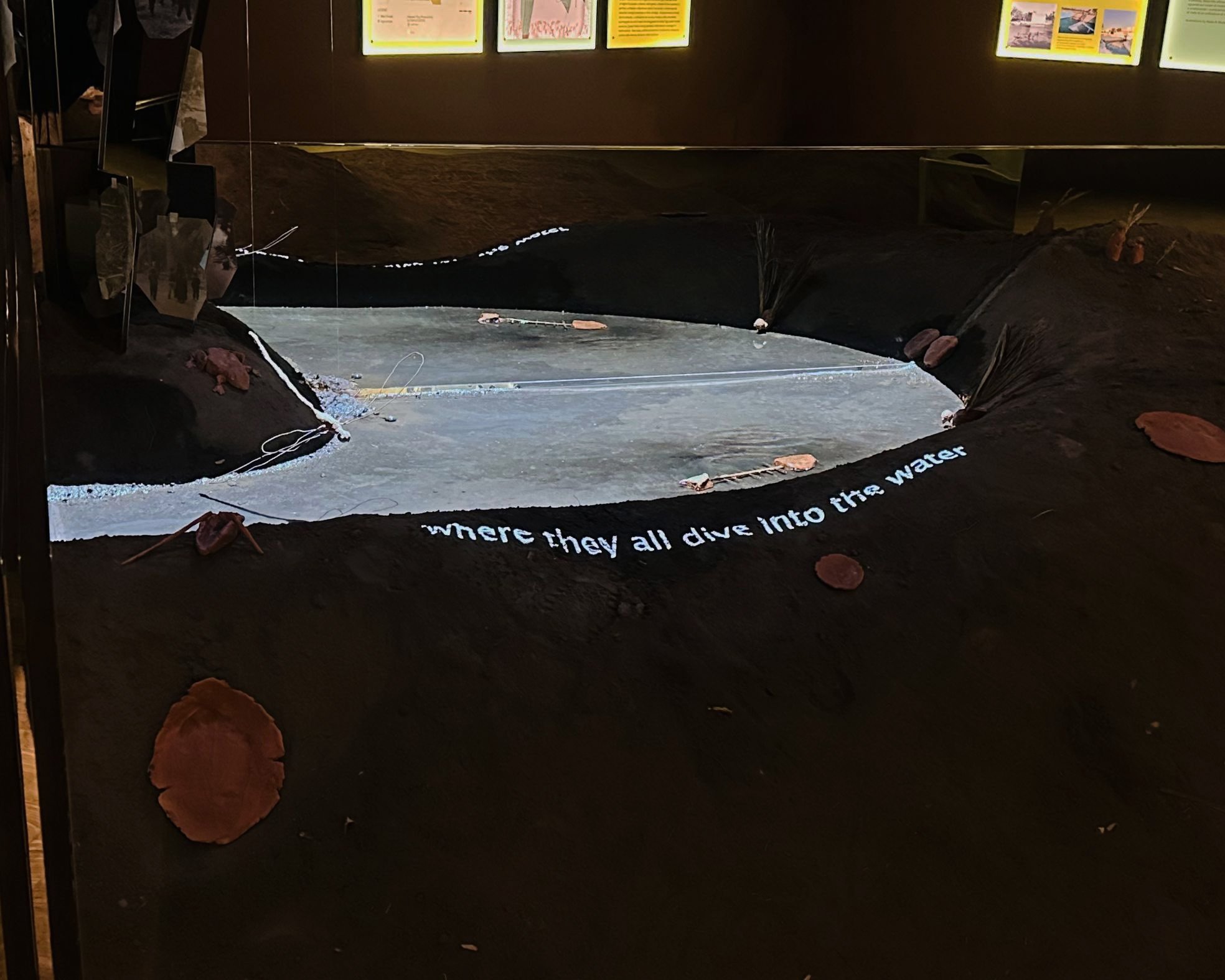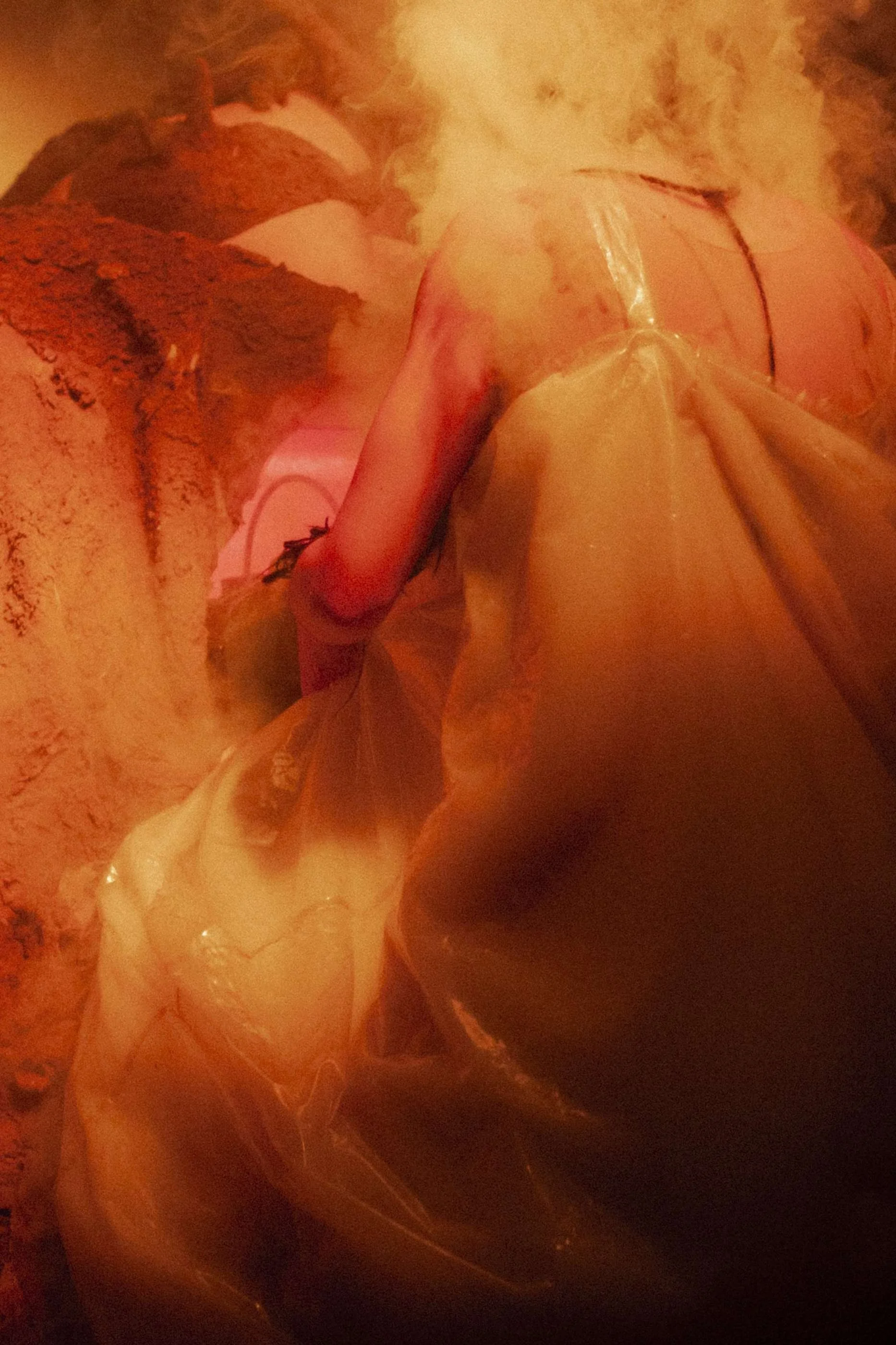Maghras - A farm for experimentation
TM Maghras, A Farm for Experimentation installation view, Image by Valentina Sommariva. Installation view of Maghras, A Farm for Experimentation at Triennale Milano
Saudi Arabia’s first national pavilion at the Triennale Milano International Exhibition doesn’t shout. It listens. Maghras, A Farm for Experimentation, curated by Lulu Almana and Sara Al Omran with Alejandro Stein, opens as a meditative fieldwork into the changing conditions of Al Ahsa—one of the world’s oldest oases and a UNESCO World Heritage Site. Rather than render the landscape as picturesque or romantic, the pavilion works with it as data, witness, and interlocutor.
Its three newly commissioned works operate like instruments in a shared system of inquiry. Leen Ajlan reconstructs agricultural byproduct waste into architecture, confronting the quiet consequences of monoculture. Mohammed Alfaraj repositions a local folk tale, not for nostalgia, but to question how memory holds under technological and environmental stress. Sawtasura composes a sonic essay from oral accounts—voices rarely archived, never diagrammed—centered on women’s environmental memory and their roles as cultural transmitters.
Maghras it’s a provocation calibrated with restraint. Its strength lies in its refusal to over-narrate. Instead, it stages an open study of material conditions, ecological intelligence, and inherited knowledge. A measured debut, grounded and deliberate.
Magras examines what happens when a region is written out of the dominant narrative. While cities absorb capital and attention, places like Al-Hasa—the once-thriving agricultural oasis in eastern Saudi Arabia—are left to weather the quiet violence of disappearance.
This exhibition doesn't pretend to solve that. It offers something rarer: a detailed observation. Grounded in oral histories, archival drawings, and direct engagement with local communities, Magras is rooted in the stories of those who have lived these transitions. Rice farmers adjusting to water policies. Vendors displaced by new planning codes. Craftspeople watching their materials—and their practices—dry up.
The name Magras refers to an old local measure of land: the space between four palm trees. It’s a term few remember, but its logic remains embedded in the soil, in memory, in the shared vernacular of survival.
In a context where culture is often filtered through technical or institutional lenses, Magras looks elsewhere: to the residue, to the pause, to the parts of a place that are harder to quantify.
SARA AL OMRAN (Curator): This is a place where life existed because of water for centuries. The natural springs only stopped flowing in the last three or four decades. In the 1990s, the last spring in Al-Ahsa completely dried up.
By "spring," we mean water that naturally comes to the surface. If you have to dig, then it's considered a well. So, the 1990s marked a visible environmental shift in the region. What we’re exploring isn’t necessarily water policy—that’s already a well-researched area in Saudi Arabia—but rather the cultural expressions that developed in relation to water, how they've become untethered from place, and how we might reimagine or preserve them as part of envisioning Al-Ahsa's future.
Right now, some of the biggest challenges the region faces are rapid urbanization and the loss of agricultural land. Al-Ahsa is home to around 2.5 million people, and there’s constant pressure to convert farmland into residential areas. We may not be able to bring the water back, but by understanding the region’s cultural identity and cues, we hope to imagine alternative trajectories for its future beyond the current path.
You mentioned rice farms outside the city—how does that relate to this shift?
The rice farms are a good example. Since water is no longer accessible in the historic oasis, farmers are moving further out into the desert to continue cultivating rice. But that has affected the quality of the crop. The land and water are simply not the same.
And that shift is something you’re observing as part of your research?
Exactly. We're looking at what it means when people move away from the historical landscape and how that impacts both agriculture and cultural memory.
Do you think the density of the population is affecting architecture and design? Are we seeing irreversible changes in the physical landscape?
Definitely. Much of the agricultural land is being re-designated for residential use. If a plot is classified as agricultural, you’re only allowed to build a single-story structure on 10% of it. But once it becomes residential, you're permitted to build two floors and occupy more of the land.
So there’s a regulatory limit on building when it’s agricultural land?
Yes. Once that classification changes, there's an immediate pressure to build more. People are also looking for more affordable housing options, and agricultural plots become the most obvious targets for expansion.
But even that—shifting from one to two floors—feels quite limited, especially considering the density you described.
It is limited, yes. But these are the kinds of restrictions and negotiations that are constantly at play. It’s also an area we’d like to investigate further in the future.
You also mentioned that Al-Ahsa is made up of villages surrounding larger metropolitan areas. How does that impact development?
In Saudi Arabia, the planning system is binary: you're either designated as a village or a city. Villages don’t receive the same level of investment—you might not have access to higher education institutions or adequate healthcare facilities. So there’s a push from older generations to reclassify their villages as towns or cities in order to attract more resources.
But that reclassification comes at a cost. It leads to road expansion and more land being taken from agriculture. There's a tension between preserving the agricultural identity and embracing modernization. For some, keeping the agricultural classification feels like being held back. For others, it’s a vital part of the region’s cultural identity.
TM Saudi Arabia, Image by Mohammad Alfaraj. Frog at an irrigation pool, Qurain Village
Let’s talk about the photographs on view—these are from workshops, right? When were they held?
Yes, these are from workshops we held over the past year.
What kind of activities took place in those workshops?
They were led by Tara Al Dughaither, whose audio work is also playing in the space. We wanted to offer visitors a sense of the workshops through both sound and image.
To immerse people more directly into the atmosphere?
Exactly. Some of the exercises included walks through the farms, sketching sessions, sound explorations, and body movement prompts. Tara focused on sensory memory and site-specific engagement. Each palm tree here represents a workshop we held.
TM Saudi Arabia, Image by Alejandro Stein. Date harvest spread across two maghras
TM Saudi Arabia, Image by Alejandro Stein. A portal lies against a palm tree near a demolition site
TM Saudi Arabia_Image courtesy of Maghras. Al Ahsa oasis
And this was all during the past year?
Yes, between October 2024 and April 2025.
Are there plans to continue the program?
This was our first cycle—our "first harvest," so to speak. We're using the current exhibition period to reflect on what worked, how people responded, and how the artists felt. Then we’ll resume again in October with a clearer sense of direction.
TM Saudi Arabia_Image by Moaath Alyahya. The harvest gathering brought together the community of artists, researchers, and contributors who helped bring Maghras to life.
Interview by DONALD GJOKA
What to read next

















